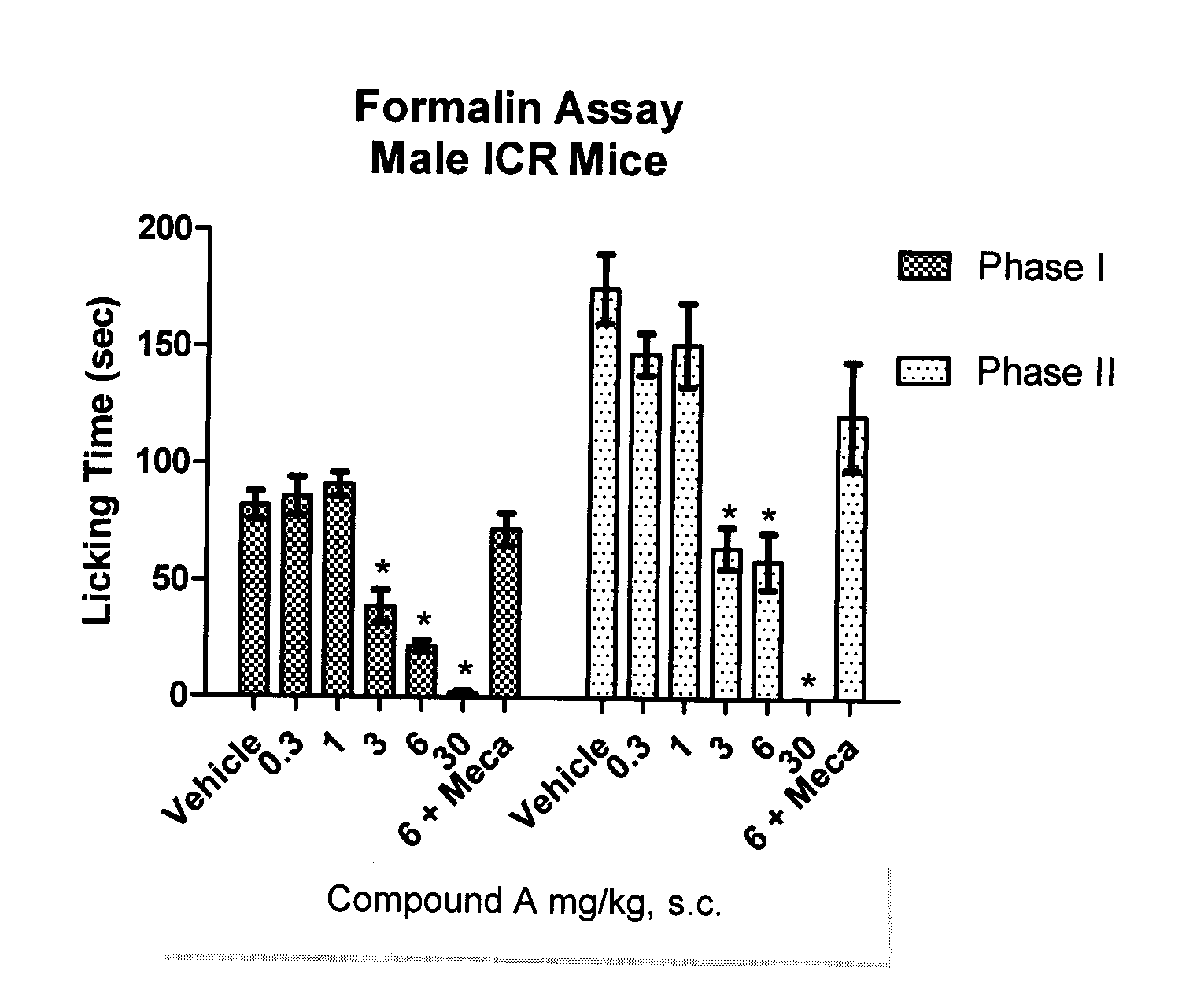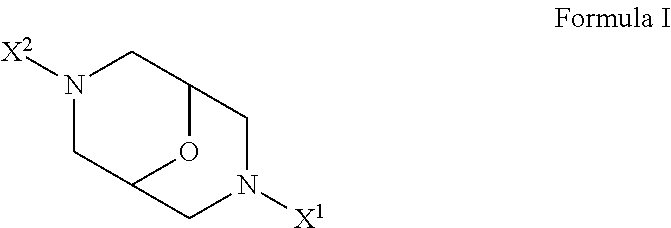Derivatives of oxabispidine as neuronal nicotinic acetylcholine receptor ligands
a technology of neuronal nicotinic acetylcholine and derivatives, which is applied in the direction of drug compositions, organic chemistry, nervous disorders, etc., can solve the problems of various undesirable side effects and association, and achieve the effect of alleviating pain and inflammation and high affinity
- Summary
- Abstract
- Description
- Claims
- Application Information
AI Technical Summary
Benefits of technology
Problems solved by technology
Method used
Image
Examples
example 1
[0201]Example 1 is the synthesis of 9-oxa-3,7-diazabicyclo[3.3.1]nonane, suitably protected (preferably with either a Boc or a Cbz group) for use in N-aryl coupling reactions.
N-(Benzyloxycarbonyl)diallylamine
[0202]Benzyl chloroformate (0.33 mol, 50 mL) was added to a solution of diallylamine (0.30 mol, 37 mL) and triethylamine (0.33 mol, 46 mL) in dichloromethane (300 mL). The reaction mixture was allowed to stir at ambient temperature overnight. The mixture was washed with water (4×75 mL), and the organic phase was separated, dried over magnesium sulfate, and concentrated by rotary evaporation to give a light brown oil. The oil was purified by silica gel flash chromatography (3:1 hexanes / ethyl acetate) to yield 47 g (68%) of N-benzyloxycarbonyl diallylamine as a colorless oil.
N-(Benzyloxycarbonyl)-2,6-bis(mercurylmethyl)morpholine diacetate
[0203]To a solution of mercury(II) acetate (0.130 mol, 41.4 g) in water (120 mL) was added N-(benzyloxycarbonyl)diallylamine (0.065 mol, 15 g). ...
examples 2-4
[0208]Examples 2-4 involve coupling reactions of 3-(t-butoxycarbonyl)-9-oxa-3,7-diazabicyclo[3.3.1]nonane with various aryl halides. As will be appreciated by those skilled in the art, in some cases, such coupling reactions are palladium catalyzed; in other cases (such as example 3), no palladium catalyst is necessary, as some aryl halides are sufficiently reactive toward nucleophilic substitution such that the coupling can be accomplished without catalysis.
example 2
3-(5-Fluoropyridin-3-yl)-9-oxa-3,7-diazabicyclo[3.3.1]nonane trifluoroacetate
[0209]5-Bromo-3-fluoropyridine (1.14 g, 6.48 mmol) and 3-(t-butyloxycarbonyl)-9-oxa-3,7-diazabicyclo[3.3.1]nonane (1.14 g, 5.00 mmol) were combined in dry toluene (45 mL), followed by addition of tris(dibenzylideneacetone)dipalladium (91.6 mg, 0.100 mmol), 4,5-bis(diphenylphophino)-9,9-dimethylxanthene (174 mg, 0.301 mmol), and sodium t-butoxide (721 mg, 7.51 mmol). The reaction vessel was flushed with argon and the reaction solution was allowed to stir at 95° C. for 3 hours. The reaction mixture was cooled to ambient temperature, diluted with ethyl acetate (30 mL), and washed with water (10 mL). The organic layer was separated and concentrated under reduced pressure. The residue was purified by HPLC to yield 3-(t-butoxycarbonyl)-7-(5-fluoropyridin-3-yl)-9-oxa-3,7-diazabicyclo[3.3.1]nonane (0.81 g, yield 50%). This was dissolved in dichloromethane / trifluoroacetic acid (1:1) (3 mL) and stirred for 1 h. The r...
PUM
| Property | Measurement | Unit |
|---|---|---|
| weight | aaaaa | aaaaa |
| concentration | aaaaa | aaaaa |
| concentration | aaaaa | aaaaa |
Abstract
Description
Claims
Application Information
 Login to View More
Login to View More - R&D
- Intellectual Property
- Life Sciences
- Materials
- Tech Scout
- Unparalleled Data Quality
- Higher Quality Content
- 60% Fewer Hallucinations
Browse by: Latest US Patents, China's latest patents, Technical Efficacy Thesaurus, Application Domain, Technology Topic, Popular Technical Reports.
© 2025 PatSnap. All rights reserved.Legal|Privacy policy|Modern Slavery Act Transparency Statement|Sitemap|About US| Contact US: help@patsnap.com



